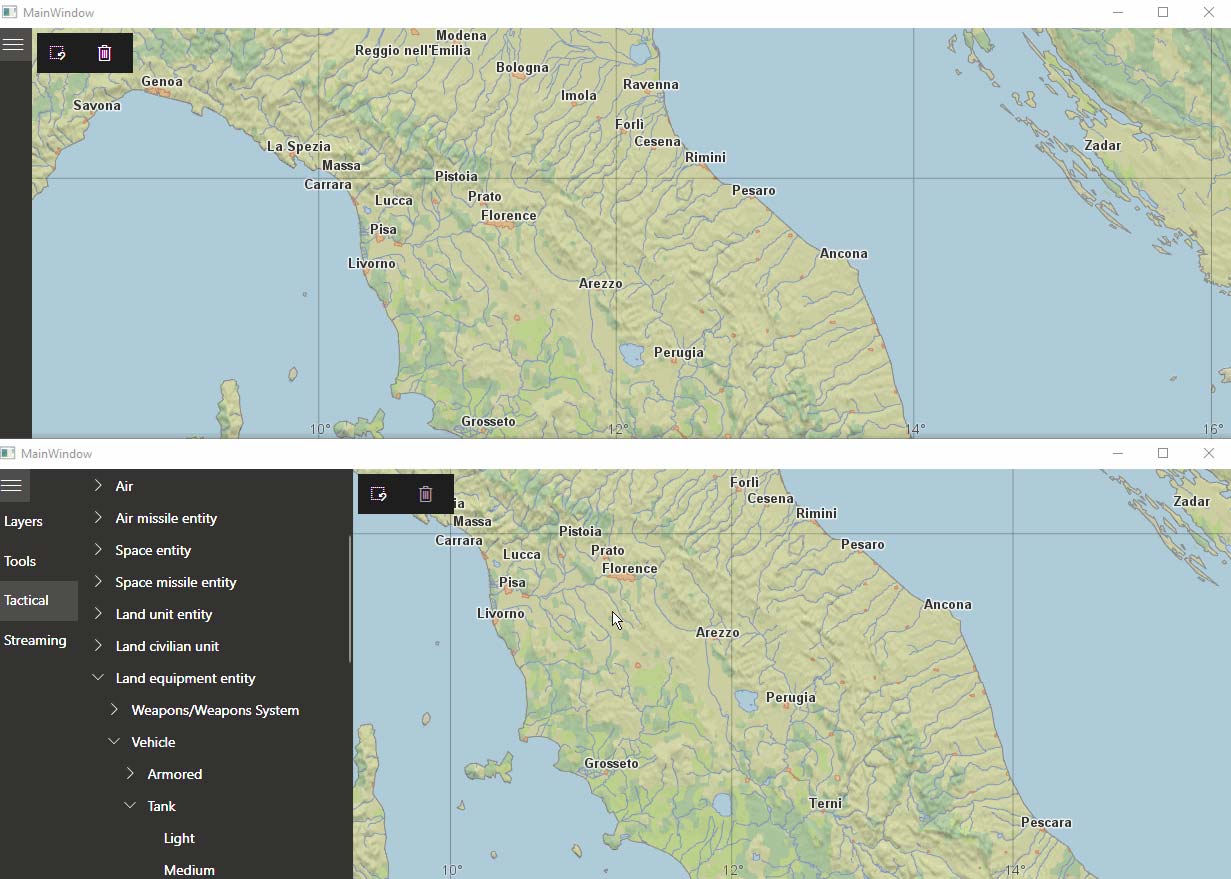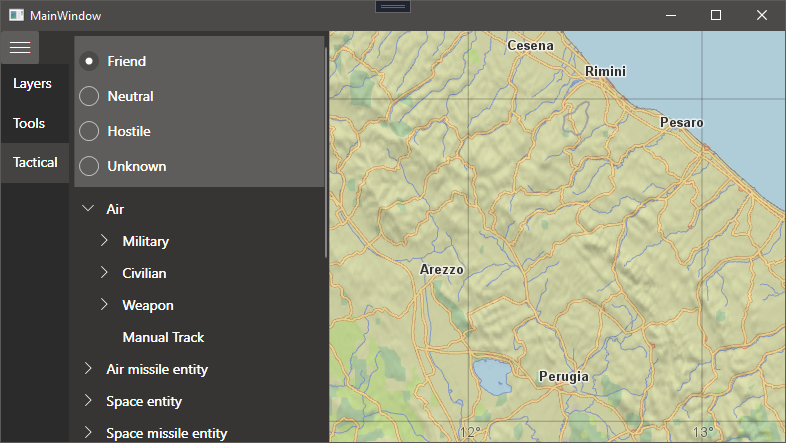In the previous tutorial, we added support for the basic creation and editing of geographical features. This tutorial will take the concept a step further and add support for tactical symbols. If you didn’t follow along with the previous tutorials in this series, please complete those first.
- Creating a basic WPF Client with MVVM
- Adding feature editing tools to the WPF client application
We will start this article by building up a new menu where a hierarchical list of tactical symbol metadata will be visualized for selection. We will then add options for specifying the affiliation when creating symbols. Finally, we will extend the MapViewModel to handle adding and editing symbols.
This archive contains the solution outlined in this article.
Prerequisites
You will need a license to use Tactical Extension in order to be able to follow along with this tutorial.
Carmenta Engine Tactical Extension
With the Tactical Extension for Carmenta Engine, one can access a set of components that can be used to create and manage tactical overlays for a map. The supported standards in Carmenta Engine are the MIL-STD standards specified by the US Department of Defense:
- MIL-STD-2525B
- MIL-STD-2525C
- MIL-STD-2525D
As well as the NATO APP-6 standards:
- App-6(B)
- App-6(C)
- App-6(D)
There are some things to take into consideration when using the different standards in Carmenta Engine, so please see the documentation for the details.
In this article, we will be working with the MIL-STD-2525D standard.
Creating the View and ViewModels
We will start by creating the View and ViewModel for managing tactical symbols. Start by creating a ViewModel class in ViewModels\TacticalSymbolsMenuViewModel.cs. We will create a private field containing information about a symbol standard by using the SymbolStandard class in Carmenta Engine. On the SymbolStandard class we can access properties for specific standards, in this case we will use the SymbolStandard.MilStd2525D property:
using Carmenta.Engine;
using CarmentaWpfClient.Messages;
using CommunityToolkit.Mvvm.ComponentModel;
using CommunityToolkit.Mvvm.Input;
using CommunityToolkit.Mvvm.Messaging;
using System.Collections.Generic;
using System.Windows;
namespace CarmentaWpfClient.ViewModels
{
public partial class TacticalSymbolsMenuViewModel : ObservableObject
{
private readonly SymbolStandard _symbolStandard = SymbolStandard.MilStd2525D;
private SymbolMetadata? _currentSymbolMetadata;
private string _affiliation = "Friend";
public IEnumerable<SymbolMetadata> Symbols => _symbolStandard.Metadata.ChildSymbols;
public string Affiliation
{
get => _affiliation; set
{
_affiliation = value;
SendUpdateMessage();
}
}
[RelayCommand]
public void SelectionChanged(RoutedPropertyChangedEventArgs<object>? args)
{
if (args?.NewValue is not SymbolMetadata symbolMetadata)
return;
_currentSymbolMetadata = symbolMetadata;
SendUpdateMessage();
}
private void SendUpdateMessage()
{
if (_currentSymbolMetadata is not null)
WeakReferenceMessenger.Default.Send(new SymbolSelectedMessage(_currentSymbolMetadata, Affiliation));
}
}
}
We’ve also created a command that will be used for handling selections in the view and an Affiliation property that will be used for handling setting the affiliation of created symbols. The SendUpdateMessage method will send a message to signal that a new symbol or affiliation has been selected.
Message for when a tactical symbol is selected
Create SymbolSelectedMessage in Messages\SymbolSelectedMessage.cs:
Messages\SymbolSelectedMessage.cs
using Carmenta.Engine;
namespace CarmentaWpfClient.Messages;
public record SymbolSelectedMessage(SymbolMetadata SymbolMetadata, string Affiliation);
It’s a simple record containing the SymbolMetadata and a string representation of the affiliation for the current symbol.
Creating the View
<UserControl x:Class="CarmentaWpfClient.Views.TacticalSymbolsMenuView"
xmlns="http://schemas.microsoft.com/winfx/2006/xaml/presentation"
xmlns:x="http://schemas.microsoft.com/winfx/2006/xaml"
xmlns:mc="http://schemas.openxmlformats.org/markup-compatibility/2006"
xmlns:d="http://schemas.microsoft.com/expression/blend/2008"
xmlns:b="http://schemas.microsoft.com/xaml/behaviors"
xmlns:controls="clr-namespace:ModernWpf.Controls;assembly=ModernWpf.Controls"
xmlns:system="clr-namespace:System;assembly=netstandard"
mc:Ignorable="d"
d:DesignHeight="450" d:DesignWidth="800">
<ScrollViewer>
<StackPanel>
<Border Background="{DynamicResource SystemControlDisabledListMediumBrush}" Margin="5" Padding="5">
<StackPanel >
<controls:RadioButtons SelectedItem="{Binding Affiliation, Mode=TwoWay}">
<system:String>Friend</system:String>
<system:String>Neutral</system:String>
<system:String>Hostile</system:String>
<system:String>Unknown</system:String>
</controls:RadioButtons>
</StackPanel>
</Border>
<TreeView ItemsSource="{Binding Symbols}">
<b:Interaction.Triggers>
<b:EventTrigger EventName="SelectedItemChanged">
<b:InvokeCommandAction Command="{Binding SelectionChangedCommand}" PassEventArgsToCommand="True" />
</b:EventTrigger>
</b:Interaction.Triggers>
<TreeView.ItemTemplate >
<HierarchicalDataTemplate ItemsSource="{Binding ChildSymbols}">
<TextBlock Text="{Binding Description}" />
</HierarchicalDataTemplate>
</TreeView.ItemTemplate>
</TreeView>
</StackPanel>
</ScrollViewer>
</UserControl>
The view specifies a group of mutually exclusive radio buttons for setting the affiliation of the symbols. These bind the SelectedItem property to the Affiliation property on the ViewModel. The TreeView component to the Symbols property on the ViewModel and the HierarchicalDataTemplate will build up the nested, tree-like structure of the symbols for the MIL-STD-2525D standard. The data template binds to the ChildSymbols property which exists on the SymbolMetadata class, and the Description is displayed in the tree view for each symbol.
Injecting the tactical symbols view model
With the View and ViewModel created, let’s add them to the application. Start by registering the TacticalSymbolsMenuViewModel as a service in App.ConfigureServices by editing App.xaml.cs:
App.xaml.cs
...
namespace CarmentaWpfClient
{
/// <summary>
/// Interaction logic for App.xaml
/// </summary>
public partial class App : Application
{
...
private static IServiceProvider ConfigureServices()
{
var services = new ServiceCollection();
...
services.AddTransient<TacticalSymbolsMenuViewModel>();
return services.BuildServiceProvider();
}
}
}
Then make sure to inject it into DrawerMenuViewModel and add a new case in the switch expression in DrawerMenuViewModel.SelectionChanged:
...
namespace CarmentaDemoWPF.ViewModels
{
public partial class DrawerMenuViewModel(
... ,
TacticalSymbolsMenuViewModel _tacticalSymbolsMenuViewModel) : ObservableObject
{
...
private void SelectionChanged(SelectionChangedEventArgs? e)
{
...
if (e.AddedItems[0] is ListBoxItem listBoxItem)
{
var tag = listBoxItem.Tag.ToString();
CurrentViewModel = tag switch
{
...
"tactical" => _tacticalSymbolsMenuViewModel,
_ => null
};
}
}
}
}
Adding the tactical symbols view to the app
With the new view model in place we have to add the view to DrawerMenuView.xaml by adding a new data template linking the TacticalSymbolsMenuViewModel to the TacticalSymbolsMenuView:
<UserControl ...>
<UserControl.Resources>
...
<DataTemplate DataType="{x:Type vm:TacticalSymbolsMenuViewModel}" >
<local:TacticalSymbolsMenuView />
</DataTemplate>
...
</UserControl.Resources>
<Grid Background="{StaticResource SystemAccentColorDark1Brush}">
...
<Grid Grid.Column="0">
...
<ListBox Grid.Row="1" Visibility="{Binding IsOpen, Converter={StaticResource BooleanToVisibilityConverter}}" SelectionMode="Extended">
...
<ListBoxItem Tag="tactical">
Tactical
</ListBoxItem>
</ListBox>
</Grid>
...
</Grid>
</UserControl>
We have also added another entry, tactical, in the drop down list of tool modes.
Tactical symbols in the map
Map Configuration
With most of the application code in place to select tactical symbols, we now have to extend our map configuration and MapViewModel to support tactical symbols as well.
We will edit the map configuration world_map.px by adding a new OrdinaryLayer towards the bottom and call it TacticalSymbolsLayer. Make the OrdinaryLayer selectable.
To the OrdinaryLayer we will add a VisualizationOperator with two TacticalVisualizer objects, one in the VisualizationOperator‘s SelectionVisualizers and one in Visualizers. The TacticalVisualizer will require a Parameter value, so add a reference to a MilStd2525DParameters to both TacticalVisualizers.
Finally, add to the VisualizationOperator a ReadOperator with a MemoryDataSet called TacticalSymbolsDataSet. The end result should look like this:






